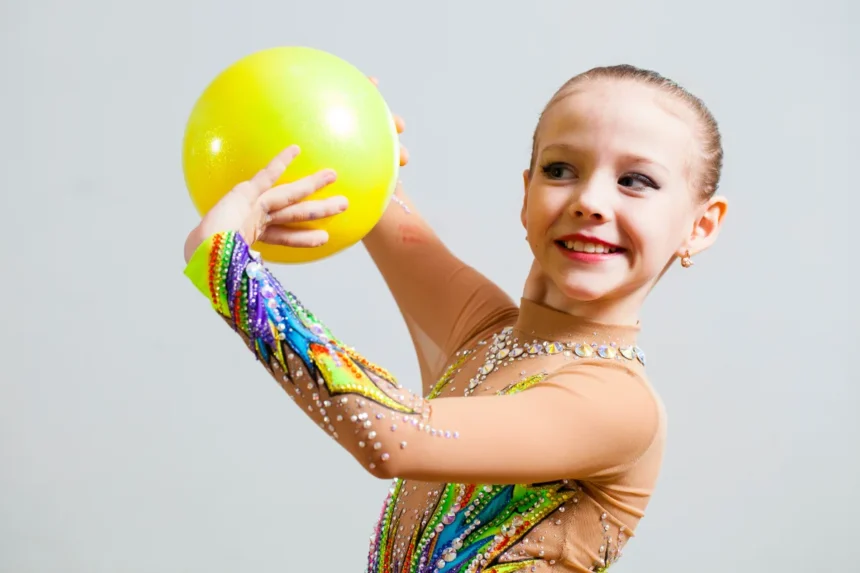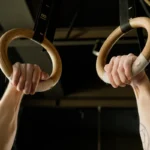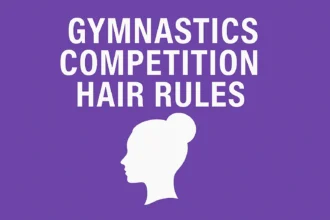Gymnastics is not one-size-fits-all. Within the sport, different disciplines emphasize different skills, styles, and strengths. Two of the most recognizable are artistic gymnastics and rhythmic gymnastics.
Both are Olympic sports under the International Gymnastics Federation (FIG), yet they look completely different in practice. Here’s a clear breakdown of each style, and some guidance on which one might be best for your child.
Artistic Gymnastics: The Classic Form You See at the Olympics
When most people picture gymnastics, they think of artistic gymnastics. This is the discipline where athletes flip on the vault, swing between bars, balance on the beam, or tumble across the floor. It’s the Olympic standard, practiced by both boys and girls around the world, and has been a core event since the early 20th century.
Events for Girls (WAG)
- Vault
- Uneven Bars
- Balance Beam
- Floor Exercise
Events for Boys (MAG)
- Floor Exercise
- Pommel Horse
- Still Rings
- Vault
- Parallel Bars
- High Bar
Why It Stands Out
Artistic gymnastics develops a broad spectrum of physical qualities—strength, power, flexibility, coordination, balance, and body awareness. Young athletes start with foundational skills like rolls, handstands, and cartwheels, then gradually progress to more advanced tumbling, bar swings, and flips.
It’s not just about acrobatics, though. On the women’s side especially, artistry plays a role. Floor and beam routines include dance elements, choreography, and expression, with judges rewarding fluid movement and performance quality alongside technical execution.
Pathway for Kids
For children, artistic gymnastics is often the gateway into the sport. Recreational classes usually begin with tumbling on soft mats, obstacle courses, and basic apparatus work.
As they advance, kids can choose recreational participation or competitive tracks, such as the USAG Development Program (Levels 1–10, leading to Elite) or the more flexible Xcel Program, which balances skill progression with lower time commitment.
Artistic gymnastics is a great fit for children who are energetic, adventurous, and excited by the challenge of flips, swings, and dynamic skills.
Rhythmic Gymnastics: Dance Meets Acrobatics with Apparatus
Rhythmic gymnastics offers a completely different expression of gymnastics. Instead of large, fixed apparatus, athletes perform on a carpeted floor using handheld equipment: ribbon, hoop, ball, clubs, and rope.
At the Olympic level, rhythmic gymnastics is a female-only discipline, although boys’ programs do exist in some countries like Japan and Spain.
What It Looks Like
A rhythmic routine blends ballet, modern dance, and acrobatics, always set to music. The gymnast must combine leaps, balances, turns, and flexibility elements with continuous handling of the apparatus. Each piece of equipment adds its own flavor:
- Ribbon: Creates flowing patterns, spirals, and waves in the air.
- Hoop: Rolled, spun, tossed, and caught with seamless timing.
- Ball: Balanced on the body, thrown overhead, or smoothly rolled across arms and back.
- Clubs: Require precise juggling-style throws and catches.
- Rope: Skipping, swings, and intricate jumps (used more in junior-level routines than in Olympic competition).
Why It Stands Out
Rhythmic gymnastics does not involve flips or vaults. Instead, it highlights artistry, presentation, rhythm, and extreme flexibility. Judges evaluate routines on difficulty, execution, and artistry, with heavy weight placed on musicality and performance quality.
The style makes rhythmic gymnastics especially appealing for children who enjoy dance, music, and expressive movement, but still want the challenge and discipline of a structured, competitive sport. It nurtures posture, grace, and coordination while still demanding strength and endurance.
Which One Is Best for Kids?
The answer depends on your child’s personality, interests, and natural strengths.
Artistic Gymnastics May Be Best If…
- Your child loves climbing, tumbling, and flipping.
- They have lots of energy and power.
- They enjoy learning new tricks on different apparatuses.
- They thrive in environments that challenge both strength and courage.
Artistic gymnastics is excellent for developing overall athleticism, which transfers well into other sports later in life if the child chooses not to pursue gymnastics long term.
Rhythmic Gymnastics May Be Best If…
- Your child enjoys dance and music.
- They have natural grace, flexibility, and coordination.
- They prefer expressive, performance-based activities.
- They like working with props (ribbons, hoops, balls).
Rhythmic gymnastics can be a great option for kids who lean toward the artistic side, blending athletic training with creative expression.
Quick Comparison Table
| Feature | Artistic Gymnastics | Rhythmic Gymnastics |
|---|---|---|
| Participants | Boys and girls (different apparatus) | Girls/women at Olympic level (boys in some nations) |
| Apparatus | Fixed equipment: vault, bars, beam, rings, etc. | Handheld: ribbon, hoop, ball, clubs, rope |
| Focus | Strength, power, acrobatics, technical precision | Flexibility, grace, rhythm, artistry |
| Routine Style | Flips, vaults, dynamic tumbling | Dance-like choreography, always to music |
| Scoring | Difficulty (D) + Execution (E) | Difficulty + Execution + Artistry |
| Best For Kids Who… | Love climbing, flipping, and physical challenges | Love dance, music, and expressive performance |
Ultimately, the best approach is to let kids try both if possible. Many gyms offer recreational programs where children can explore different gymnastics styles before committing.






